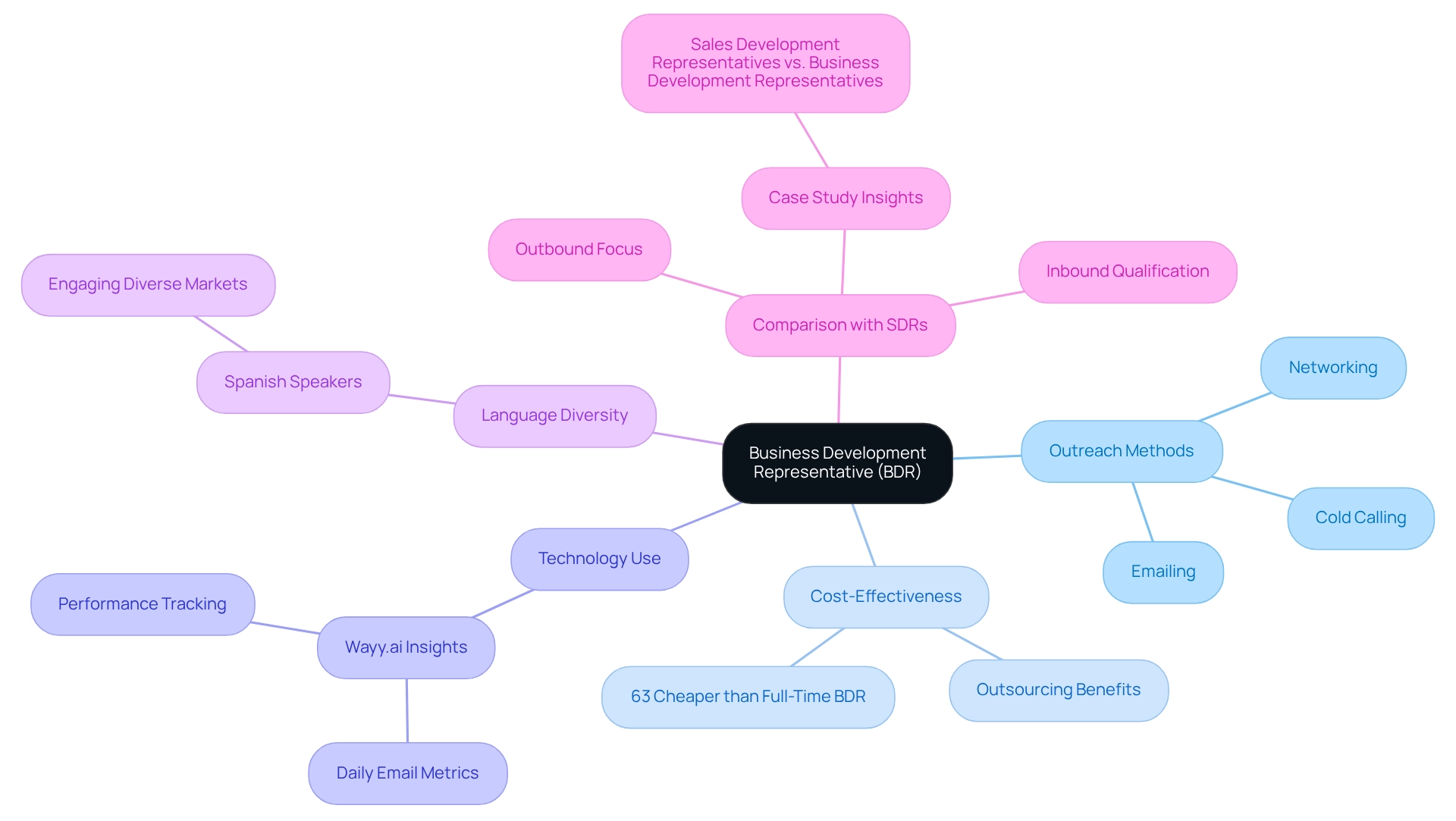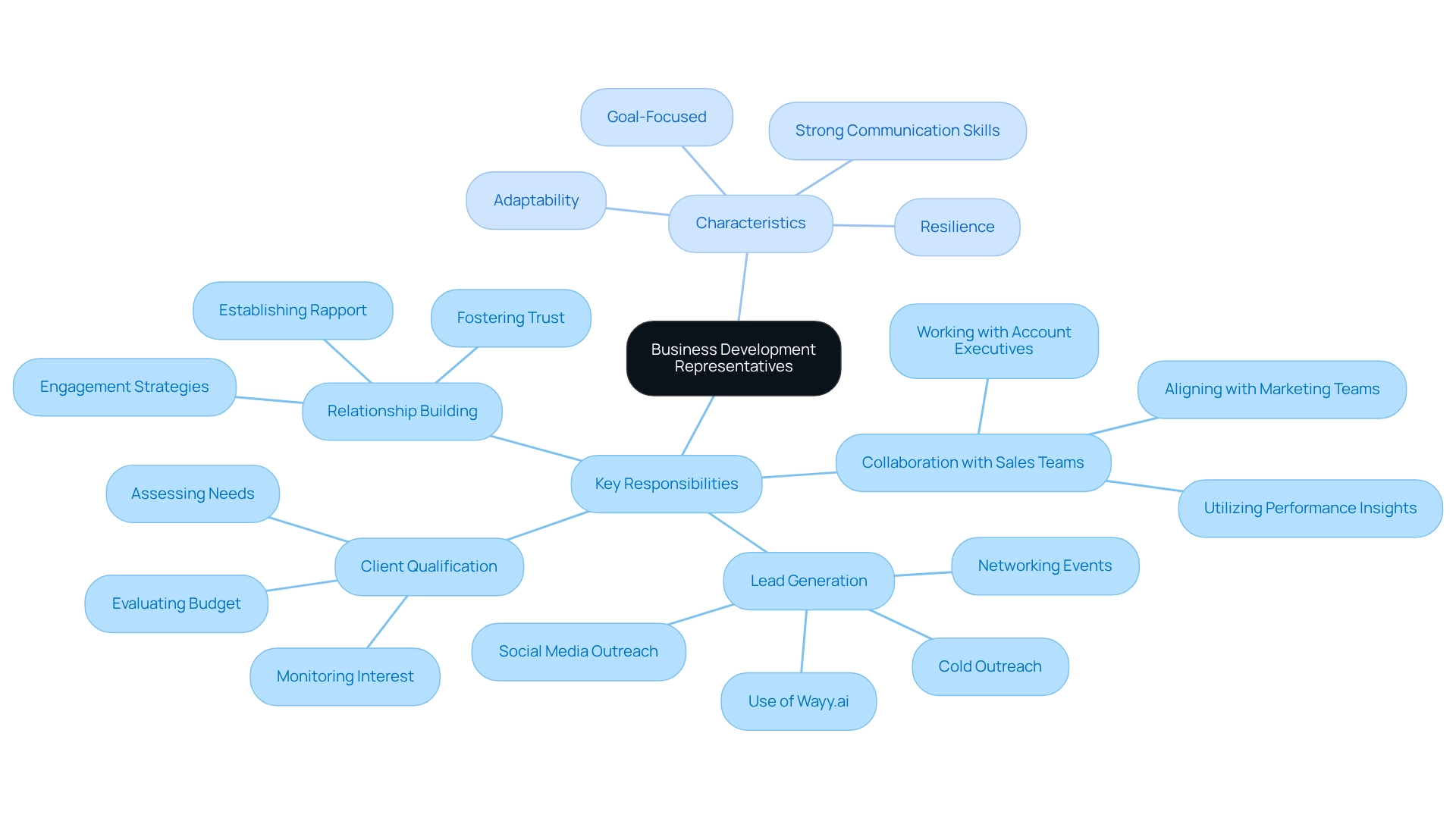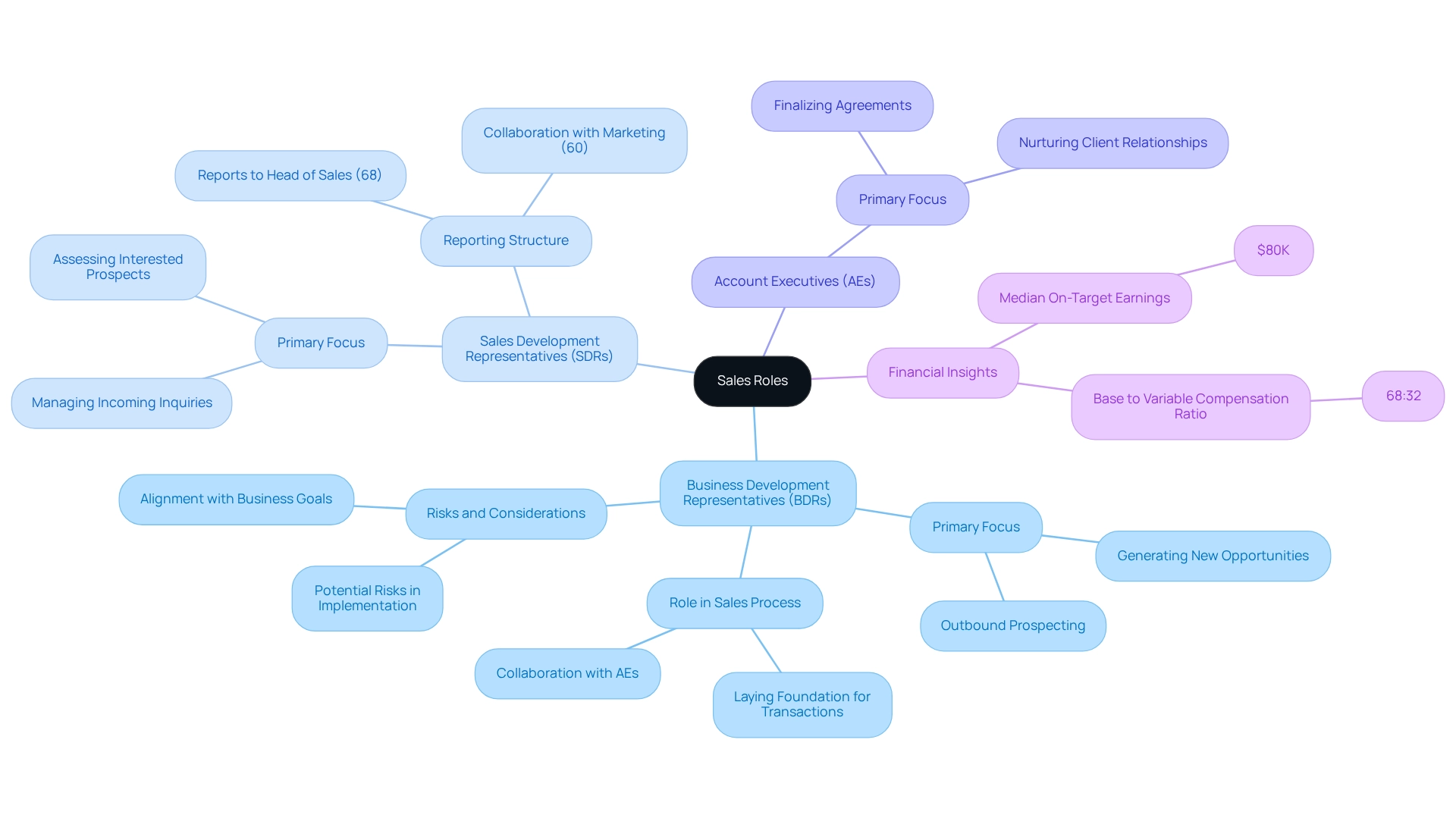Overview
The article highlights the importance of a Business Development Representative (BDR) in generating new business opportunities. Through outreach efforts such as cold calling and networking, BDRs play a pivotal role in enhancing sales performance for small enterprises. We understand the challenges you face, and a BDR can be a valuable partner in building meaningful relationships that drive revenue.
Moreover, the article emphasizes the cost-effectiveness of BDRs, supported by data that showcases their growing importance in today’s technology-driven landscape. By optimizing their strategies, BDRs not only help in achieving immediate sales goals but also contribute to long-term success.
Ultimately, investing in a BDR could be the key to unlocking new avenues for growth. Together, we can navigate these opportunities and create a brighter future for your business.
Introduction
In the ever-evolving landscape of sales, we understand that Business Development Representatives (BDRs) play a vital role in driving growth and expanding market reach. As essential players, BDRs are tasked with the important responsibility of generating new business opportunities. They engage in proactive outreach methods to identify and qualify leads, laying a solid foundation for future sales success.
As more businesses recognize the cost-effectiveness and strategic value of BDRs—especially in competitive markets—their significance continues to grow. This article explores the multifaceted role of BDRs, delving into their key responsibilities, the impact of technology on their effectiveness, and how they distinguish themselves from other sales roles.
Together, we can navigate this journey and shape the future of sales strategies.
Define Business Development Representative (BDR)
A Business Development Representative (BDR) plays a vital role in creating new business opportunities, and we recognize the BDR meaning for small enterprises. Their primary focus is on identifying and evaluating prospects through various outreach methods, such as cold calling, emailing, and networking. By initiating contact with potential clients, business development representatives build relationships that are essential for turning leads into viable opportunities. In competitive markets, where the ability to make initial connections can significantly influence overall revenue, this position becomes even more important.
Looking ahead to 2025, the role of development representatives in sales is increasingly significant. Did you know that employing a development representative can be about 63% more affordable than hiring a full-time representative in high-cost areas like San Francisco? This cost-effectiveness makes these representatives an attractive option for small businesses eager to improve their client acquisition strategies. Moreover, having Spanish speakers among representatives enhances their ability to engage with diverse markets, broadening the potential client base and enabling small businesses to reach a wider audience.
Effective BDR strategies for small enterprises often involve leveraging technology and data analytics to improve outreach efforts and increase prospect generation. With tools like Wayy.ai, business development representatives can gain valuable daily email insights that highlight key metrics, such as the number of contacts reached, the level of interest shown, and the conversion rates. This information empowers them to track their performance and make informed decisions. As Joe Flanagan wisely notes, "Any representative deserving of their reputation should have a comprehensive grasp of their product and be able to address prospects’ questions." This underscores the importance of the insights provided by Wayy in equipping business development representatives with the knowledge necessary for effective engagement.
By focusing on outbound prospects, business development representatives complement the efforts of sales development representatives (SDRs), who typically qualify incoming opportunities. The distinction between these roles is highlighted in the case study 'Sales Development Representatives vs. Business Development Representatives,' which clarifies that while both positions are essential for prospect generation, the BDR meaning indicates that business development representatives concentrate on outbound opportunities. This comprehensive approach maximizes growth and conversion chances, ultimately supporting small businesses in achieving their goals together.

Context and Importance of BDRs in Sales
In the dynamic world of modern commerce, Business Development Representatives play a vital role in effective sales teams. As the primary point of contact for potential clients, they are essential in generating and qualifying opportunities. By focusing on outreach and relationship-building, these representatives enhance market penetration and ensure a steady flow of qualified prospects into the sales pipeline. This dual role not only stimulates immediate revenue but also nurtures lasting customer connections, which are crucial for sustainable business growth.
Current trends reveal that teams with well-defined goals and clear compensation frameworks experience higher retention rates among business development representatives, with improvements of 12-15%. Moreover, teams are twice as likely to have expanded over the past year than to have contracted, underscoring the growing importance of these representatives in boosting revenue efforts. As the marketing landscape evolves, the integration of AI tools, such as those offered by Wayy.ai, has become increasingly common. These tools provide daily email updates with essential metrics on leads contacted, interest expressed, and conversion rates. They also offer a one-click playbook for sales strategies and targeted outreach capabilities, enabling business development representatives to enhance their efficiency while maintaining the significance of human interaction. This technological adoption aligns with the rising emphasis on long-term customer value, as shown by recent compensation trends that link remuneration to sustainable business outcomes.
The global D2D market, valued at $200.14 billion in 2022, is projected to grow at an annual rate of 6.4% through 2030, highlighting the importance of business development representatives in a thriving industry. Case studies indicate that while persistence in follow-up is common—averaging 53 days—this duration does not necessarily correlate with quota attainment. This finding emphasizes the importance of engagement quality over mere quantity. As companies adapt to shifting market conditions, the role of business development representatives is increasingly recognized as essential for achieving revenue goals and fostering customer loyalty, reinforcing their significance in contemporary sales strategies.

Key Responsibilities and Characteristics of BDRs
Business Development Representatives play a vital role in driving revenue success through several key responsibilities that resonate with the challenges you face as a small business owner:
- Lead Generation: They actively seek potential clients through various channels, including social media, networking events, and cold outreach, ensuring a steady influx of prospects. With tools like Wayy.ai, they can optimize client acquisition through one-click sales guides and targeted outreach, enhancing the efficiency of their efforts.
- Client Qualification: Evaluating prospects by assessing their needs, budget, and readiness to buy is essential for effective sales strategies. Daily performance insights from Wayy.ai, including email updates with key metrics, enable business development representatives to monitor how many potential clients were reached and who expressed interest, allowing them to prioritize their efforts effectively.
- Relationship Building: Establishing rapport with prospects is crucial for fostering trust and encouraging ongoing engagement, which can significantly impact conversion rates. By utilizing Wayy.ai's metrics on conversion rate enhancements, business development representatives can refine their approaches to better connect with prospective clients.
- Collaboration with Sales Teams: Business development representatives work closely with account executives and marketing teams to facilitate a seamless transition of qualified prospects into the sales process, enhancing overall efficiency. The insights provided by Wayy.ai can further enhance this collaboration by ensuring that all team members are aligned on lead status and performance metrics.
BDRs have reported achieving an impressive average of 88% of their quota targets, reflecting a positive trend in performance. Successful business development representatives typically demonstrate strong communication skills, resilience, adaptability, and a proactive mindset. They are goal-focused and motivated to achieve or surpass revenue objectives, making them invaluable contributors to any sales team. Recent research emphasizes that these traits are vital for managing the intricacies of client acquisition and oversight, especially in small companies where resources might be constrained.
Moreover, as observed by Becc Holland, founder and CEO of Flip the Script, many business development representatives transition into positions in sales management, revenue operations, customer success, or marketing, based on their strengths and long-term aspirations. This illustrates the growth and opportunities available for successful business development representatives. Furthermore, sales development representatives and sales representatives are essential for advancing prospects through the pipeline, creating qualified opportunities for new ventures, highlighting their important role in the process. The survey encompassed 262 sales development representatives, mainly from the Technology & Software sector, with 87% situated in North America, providing a clearer view of the sales development representative landscape and the significance of these findings to small business owners like you.

Distinguishing BDRs from Other Sales Roles
Business Development Representatives play a vital role in the sales ecosystem, particularly in outbound prospecting, which aligns with the bdr meaning of generating new opportunities. Their primary focus is on actively seeking fresh business prospects, which distinguishes them from Sales Development Representatives (SDRs) and Account Executives (AEs). While BDRs are instrumental in creating opportunities, SDRs typically manage incoming inquiries and assess prospects who have already expressed interest in the company's offerings. AEs, in contrast, step in after prospects have been evaluated, concentrating on finalizing agreements and nurturing client relationships.
This clear division of responsibilities enhances the effectiveness of sales teams. It allows BDRs to lay a solid foundation for future transactions while AEs focus on transforming those prospects into loyal clients. Understanding these distinctions is crucial for organizations aiming to improve their revenue processes, which relate to the bdr meaning. For instance, did you know that the median on-target earnings for revenue-generating roles are around $80K? This is accompanied by a base to variable compensation ratio of 68:32, highlighting the financial benefits associated with effective lead generation and conversion strategies.
Moreover, statistics reveal that in 68% of cases, SDRs report to the head of sales, while 60% of inbound teams work closely with marketing. This illustrates the structured hierarchy within sales organizations, which can be comforting to know as you navigate your own growth strategies. However, while BDRs offer numerous advantages, understanding the bdr meaning is important to acknowledge the potential risks associated with their implementation in growth strategies. Organizations must thoughtfully evaluate these risks when adapting or continuing BDR programs to ensure alignment with overarching goals.
By recognizing the unique roles of BDRs in comparison to SDRs and AEs, businesses can ensure that each position effectively contributes to broader sales objectives. Together, we can drive growth and success, understanding that each step taken is a move towards a more prosperous future.

Conclusion
The role of Business Development Representatives (BDRs) is increasingly recognized as essential in today’s sales landscape. By focusing on lead generation and qualification, BDRs lay the groundwork for successful sales initiatives. Their proactive outreach methods not only create immediate sales opportunities but also nurture long-term customer relationships that are vital for sustainable growth.
As technology continues to shape the sales environment, tools like Wayy.ai empower BDRs to enhance their effectiveness through data-driven insights and streamlined processes. This integration of technology not only boosts productivity but also aligns with the evolving expectations of modern sales strategies, where quality engagement surpasses mere quantity of outreach.
Moreover, understanding the distinct roles within sales teams—specifically the differences between BDRs, SDRs, and AEs—enables organizations to optimize their sales processes and maximize growth potential. As BDRs continue to play a pivotal role in expanding market reach and generating qualified leads, their contributions are crucial for achieving overall sales success.
In conclusion, investing in BDRs and recognizing their strategic importance is not just a trend; it is a necessary step for businesses aiming to thrive in competitive markets. By embracing their role, you can significantly enhance your sales performance and drive sustainable business outcomes. Together, we can recognize BDRs as invaluable assets in the quest for growth and success.
Frequently Asked Questions
What is the role of a Business Development Representative (BDR)?
A Business Development Representative (BDR) is responsible for creating new business opportunities by identifying and evaluating prospects through outreach methods such as cold calling, emailing, and networking. They build relationships with potential clients to turn leads into viable opportunities.
Why is the BDR role important for small enterprises?
The BDR role is crucial for small enterprises because it helps them make initial connections in competitive markets, which can significantly influence overall revenue. Additionally, employing a BDR is often more cost-effective than hiring a full-time representative, especially in high-cost areas.
How much more affordable is employing a development representative compared to a full-time representative in expensive areas?
Employing a development representative can be about 63% more affordable than hiring a full-time representative in high-cost areas like San Francisco.
How can having Spanish-speaking representatives benefit small businesses?
Having Spanish-speaking representatives allows small businesses to engage with diverse markets, broadening their potential client base and enabling them to reach a wider audience.
What strategies do effective BDRs use to improve outreach efforts?
Effective BDRs leverage technology and data analytics to enhance their outreach efforts and increase prospect generation. Tools like Wayy.ai provide valuable insights into email metrics, helping BDRs track performance and make informed decisions.
What is the difference between Business Development Representatives (BDRs) and Sales Development Representatives (SDRs)?
BDRs focus on outbound prospects, while SDRs typically qualify incoming opportunities. Both roles are essential for prospect generation, but BDRs concentrate on initiating contact with potential clients.
What is the significance of understanding the product for a BDR?
A BDR should have a comprehensive grasp of their product and be able to address prospects’ questions, which is critical for effective engagement and building trust with potential clients.




